[English] 日本語
 Yorodumi
Yorodumi- PDB-7kc0: Structure of the Saccharomyces cerevisiae replicative polymerase ... -
+ Open data
Open data
- Basic information
Basic information
| Entry | Database: PDB / ID: 7kc0 | ||||||||||||
|---|---|---|---|---|---|---|---|---|---|---|---|---|---|
| Title | Structure of the Saccharomyces cerevisiae replicative polymerase delta in complex with a primer/template and the PCNA clamp | ||||||||||||
 Components Components |
| ||||||||||||
 Keywords Keywords | REPLICATION / Polymerase delta / PCNA / primed DNA / complex | ||||||||||||
| Function / homology |  Function and homology information Function and homology informationdelta DNA polymerase complex / H3-H4 histone complex chaperone activity / DNA-templated DNA replication maintenance of fidelity / DNA amplification / zeta DNA polymerase complex / RNA-templated DNA biosynthetic process / Mismatch repair (MMR) directed by MSH2:MSH6 (MutSalpha) / meiotic mismatch repair / Processive synthesis on the lagging strand / Removal of the Flap Intermediate ...delta DNA polymerase complex / H3-H4 histone complex chaperone activity / DNA-templated DNA replication maintenance of fidelity / DNA amplification / zeta DNA polymerase complex / RNA-templated DNA biosynthetic process / Mismatch repair (MMR) directed by MSH2:MSH6 (MutSalpha) / meiotic mismatch repair / Processive synthesis on the lagging strand / Removal of the Flap Intermediate / E3 ubiquitin ligases ubiquitinate target proteins / Polymerase switching / DNA replication, removal of RNA primer / positive regulation of DNA metabolic process / SUMOylation of DNA replication proteins / maintenance of DNA trinucleotide repeats / Translesion Synthesis by POLH / Translesion synthesis by REV1 / Translesion synthesis by POLK / Translesion synthesis by POLI / PCNA complex / nucleotide-excision repair, DNA gap filling / establishment of mitotic sister chromatid cohesion / 3'-5'-DNA exonuclease activity / DNA replication proofreading / Termination of translesion DNA synthesis / lagging strand elongation / double-strand break repair via break-induced replication / postreplication repair / silent mating-type cassette heterochromatin formation / DNA strand elongation involved in DNA replication / Hydrolases; Acting on ester bonds; Exodeoxyribonucleases producing 5'-phosphomonoesters / DNA metabolic process / mitotic sister chromatid cohesion / error-free translesion synthesis / DNA polymerase processivity factor activity / leading strand elongation / regulation of DNA replication / Dual incision in TC-NER / subtelomeric heterochromatin formation / error-prone translesion synthesis / mismatch repair / translesion synthesis / base-excision repair, gap-filling / positive regulation of DNA repair / positive regulation of DNA replication / replication fork / nucleotide-excision repair / base-excision repair / DNA-templated DNA replication / double-strand break repair via nonhomologous end joining / mitotic cell cycle / 4 iron, 4 sulfur cluster binding / DNA replication / molecular adaptor activity / chromosome, telomeric region / DNA-directed DNA polymerase / DNA-directed DNA polymerase activity / nucleotide binding / DNA binding / identical protein binding / nucleus / metal ion binding / cytosol Similarity search - Function | ||||||||||||
| Biological species |  | ||||||||||||
| Method | ELECTRON MICROSCOPY / single particle reconstruction / cryo EM / Resolution: 3.2 Å | ||||||||||||
 Authors Authors | Zheng, F. / Georgescu, R. / Li, H. / O'Donnell, M.E. | ||||||||||||
| Funding support |  United States, 3items United States, 3items
| ||||||||||||
 Citation Citation |  Journal: Proc Natl Acad Sci U S A / Year: 2020 Journal: Proc Natl Acad Sci U S A / Year: 2020Title: Structure of eukaryotic DNA polymerase δ bound to the PCNA clamp while encircling DNA. Authors: Fengwei Zheng / Roxana E Georgescu / Huilin Li / Michael E O'Donnell /  Abstract: The DNA polymerase (Pol) δ of (S.c.) is composed of the catalytic subunit Pol3 along with two regulatory subunits, Pol31 and Pol32. Pol δ binds to proliferating cell nuclear antigen (PCNA) and ...The DNA polymerase (Pol) δ of (S.c.) is composed of the catalytic subunit Pol3 along with two regulatory subunits, Pol31 and Pol32. Pol δ binds to proliferating cell nuclear antigen (PCNA) and functions in genome replication, repair, and recombination. Unique among DNA polymerases, the Pol3 catalytic subunit contains a 4Fe-4S cluster that may sense the cellular redox state. Here we report the 3.2-Å cryo-EM structure of S.c. Pol δ in complex with primed DNA, an incoming ddTTP, and the PCNA clamp. Unexpectedly, Pol δ binds only one subunit of the PCNA trimer. This singular yet extensive interaction holds DNA such that the 2-nm-wide DNA threads through the center of the 3-nm interior channel of the clamp without directly contacting the protein. Thus, a water-mediated clamp and DNA interface enables the PCNA clamp to "waterskate" along the duplex with minimum drag. Pol31 and Pol32 are positioned off to the side of the catalytic Pol3-PCNA-DNA axis. We show here that Pol31-Pol32 binds single-stranded DNA that we propose underlies polymerase recycling during lagging strand synthesis, in analogy to replicase. Interestingly, the 4Fe-4S cluster in the C-terminal CysB domain of Pol3 forms the central interface to Pol31-Pol32, and this strategic location may explain the regulation of the oxidation state on Pol δ activity, possibly useful during cellular oxidative stress. Importantly, human cancer and other disease mutations map to nearly every domain of Pol3, suggesting that all aspects of Pol δ replication are important to human health and disease. | ||||||||||||
| History |
|
- Structure visualization
Structure visualization
| Movie |
 Movie viewer Movie viewer |
|---|---|
| Structure viewer | Molecule:  Molmil Molmil Jmol/JSmol Jmol/JSmol |
- Downloads & links
Downloads & links
- Download
Download
| PDBx/mmCIF format |  7kc0.cif.gz 7kc0.cif.gz | 444.5 KB | Display |  PDBx/mmCIF format PDBx/mmCIF format |
|---|---|---|---|---|
| PDB format |  pdb7kc0.ent.gz pdb7kc0.ent.gz | 360.7 KB | Display |  PDB format PDB format |
| PDBx/mmJSON format |  7kc0.json.gz 7kc0.json.gz | Tree view |  PDBx/mmJSON format PDBx/mmJSON format | |
| Others |  Other downloads Other downloads |
-Validation report
| Summary document |  7kc0_validation.pdf.gz 7kc0_validation.pdf.gz | 974.4 KB | Display |  wwPDB validaton report wwPDB validaton report |
|---|---|---|---|---|
| Full document |  7kc0_full_validation.pdf.gz 7kc0_full_validation.pdf.gz | 1012.2 KB | Display | |
| Data in XML |  7kc0_validation.xml.gz 7kc0_validation.xml.gz | 67.8 KB | Display | |
| Data in CIF |  7kc0_validation.cif.gz 7kc0_validation.cif.gz | 102.6 KB | Display | |
| Arichive directory |  https://data.pdbj.org/pub/pdb/validation_reports/kc/7kc0 https://data.pdbj.org/pub/pdb/validation_reports/kc/7kc0 ftp://data.pdbj.org/pub/pdb/validation_reports/kc/7kc0 ftp://data.pdbj.org/pub/pdb/validation_reports/kc/7kc0 | HTTPS FTP |
-Related structure data
| Related structure data |  22803MC M: map data used to model this data C: citing same article ( |
|---|---|
| Similar structure data |
- Links
Links
- Assembly
Assembly
| Deposited unit | 
|
|---|---|
| 1 |
|
- Components
Components
-DNA chain , 2 types, 2 molecules PT
| #1: DNA chain | Mass: 7681.985 Da / Num. of mol.: 1 / Source method: obtained synthetically / Source: (synth.)  |
|---|---|
| #2: DNA chain | Mass: 11677.539 Da / Num. of mol.: 1 / Source method: obtained synthetically / Source: (synth.)  |
-Protein , 4 types, 6 molecules FEGABC
| #3: Protein | Mass: 28944.051 Da / Num. of mol.: 3 Source method: isolated from a genetically manipulated source Source: (gene. exp.)  Gene: PCNA, POL30, GI526_G0000296, PACBIOSEQ_LOCUS349, PACBIOSEQ_LOCUS352, PACBIOSEQ_LOCUS359, PACBIOSEQ_LOCUS364, PACBIOSEQ_LOCUS365, PACBIOSEQ_LOCUS366, PACBIOSEQ_LOCUS371 Production host:  #4: Protein | | Mass: 124707.359 Da / Num. of mol.: 1 Source method: isolated from a genetically manipulated source Source: (gene. exp.)  Gene: POL3, GI526_G0000818 / Production host:  References: UniProt: A0A6A5Q0V0, UniProt: P15436*PLUS, DNA-directed DNA polymerase #5: Protein | | Mass: 55352.688 Da / Num. of mol.: 1 Source method: isolated from a genetically manipulated source Source: (gene. exp.)  Gene: POL31, GI526_G0003241 / Production host:  #6: Protein | | Mass: 40377.715 Da / Num. of mol.: 1 Source method: isolated from a genetically manipulated source Source: (gene. exp.)  Gene: POL32, GI526_G0003272, PACBIOSEQ_LOCUS3556, PACBIOSEQ_LOCUS3579 Production host:  |
|---|
-Non-polymers , 4 types, 5 molecules 

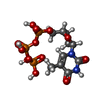




| #7: Chemical | | #8: Chemical | ChemComp-SF4 / | #9: Chemical | ChemComp-D3T / | #10: Chemical | ChemComp-ZN / | |
|---|
-Details
| Has ligand of interest | Y |
|---|
-Experimental details
-Experiment
| Experiment | Method: ELECTRON MICROSCOPY |
|---|---|
| EM experiment | Aggregation state: PARTICLE / 3D reconstruction method: single particle reconstruction |
- Sample preparation
Sample preparation
| Component |
| ||||||||||||||||||||||||
|---|---|---|---|---|---|---|---|---|---|---|---|---|---|---|---|---|---|---|---|---|---|---|---|---|---|
| Source (natural) |
| ||||||||||||||||||||||||
| Source (recombinant) | Organism:  | ||||||||||||||||||||||||
| Buffer solution | pH: 7.5 | ||||||||||||||||||||||||
| Specimen | Embedding applied: NO / Shadowing applied: NO / Staining applied: NO / Vitrification applied: YES | ||||||||||||||||||||||||
| Vitrification | Cryogen name: ETHANE |
- Electron microscopy imaging
Electron microscopy imaging
| Experimental equipment |  Model: Titan Krios / Image courtesy: FEI Company |
|---|---|
| Microscopy | Model: FEI TITAN KRIOS |
| Electron gun | Electron source:  FIELD EMISSION GUN / Accelerating voltage: 300 kV / Illumination mode: FLOOD BEAM FIELD EMISSION GUN / Accelerating voltage: 300 kV / Illumination mode: FLOOD BEAM |
| Electron lens | Mode: BRIGHT FIELD |
| Image recording | Electron dose: 68 e/Å2 / Film or detector model: GATAN K3 (6k x 4k) |
- Processing
Processing
| Software | Name: PHENIX / Version: 1.17.1_3660: / Classification: refinement | ||||||||||||||||||||||||
|---|---|---|---|---|---|---|---|---|---|---|---|---|---|---|---|---|---|---|---|---|---|---|---|---|---|
| CTF correction | Type: NONE | ||||||||||||||||||||||||
| 3D reconstruction | Resolution: 3.2 Å / Resolution method: FSC 0.143 CUT-OFF / Num. of particles: 133468 / Symmetry type: POINT | ||||||||||||||||||||||||
| Refine LS restraints |
|
 Movie
Movie Controller
Controller


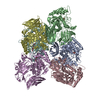
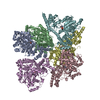

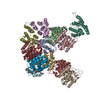
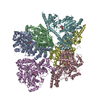

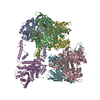
 PDBj
PDBj













































